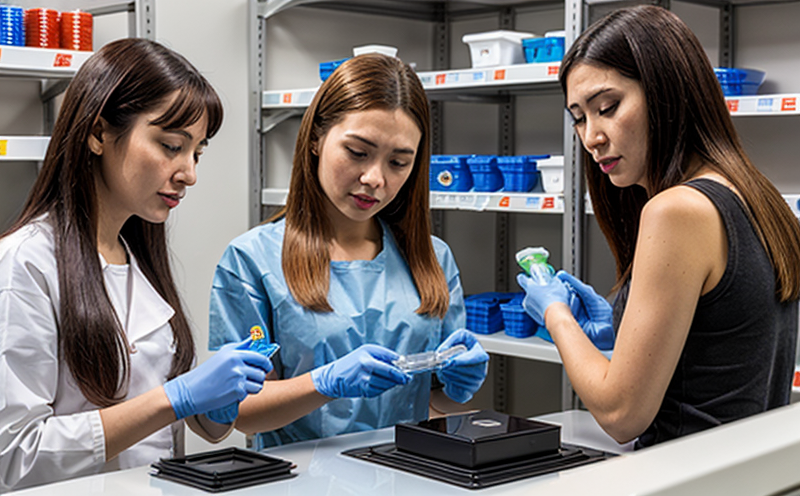EPA 8082 PCB Contaminant Testing of Consumer Plastics
The Environmental Protection Agency (EPA) has established stringent guidelines for the testing and regulation of polychlorinated biphenyls (PCBs) in consumer plastics. This service provides comprehensive testing according to EPA Method 8082, which is designed to detect and quantify PCBs in various types of plastic materials used in common household items.
Consumer products that may contain PCBs include electronics, toys, kitchenware, furniture, and packaging materials. The presence of these contaminants poses significant health risks, particularly for children and individuals with compromised immune systems. Therefore, ensuring compliance with EPA regulations is crucial for manufacturers, retailers, and consumers alike.
The testing process involves several critical steps: sample collection, preparation, extraction, purification, and analysis using advanced chromatographic techniques such as GC-ECD (Gas Chromatography-Electron Capture Detector) or LC-FLD (Liquid Chromatography-Fast Liquid Detection). The analytical methods used are sensitive enough to detect trace amounts of PCBs, ensuring accurate results.
Our laboratory strictly adheres to the EPA's Method 8082, which includes the following key components:
- Sample preparation involving thorough cleaning and drying
- Extraction using appropriate solvents and conditions
- Purification steps to eliminate matrix interferences
- Analytical determination employing both GC-ECD and LC-FLD for enhanced accuracy
The results are presented in parts per billion (ppb), which is a unit commonly used when discussing trace levels of contaminants like PCBs. Our team provides detailed reports that include all test parameters, sample descriptions, method details, and results.
Understanding the implications of this testing goes beyond mere compliance; it also plays a vital role in protecting public health. By identifying potential sources of contamination early on, manufacturers can take corrective actions to prevent further spread of these harmful substances into the environment and consumer products.
In addition to meeting regulatory requirements, our service offers valuable insights for R&D teams working on new materials or product designs. It helps them understand how changes in manufacturing processes might affect PCB content levels and guides them towards more sustainable alternatives when necessary.
Scope and Methodology
The scope of our EPA 8082 testing covers a wide range of consumer plastic products suspected or known to contain PCBs. This includes items such as household appliances, electrical components, children's toys, sporting goods, furniture, and packaging materials.
- Initial consultation with clients regarding specific concerns about their product lines
- Sampling of representative units from production batches or inventory stock
- Sending samples to our state-of-the-art laboratory for analysis
- Data interpretation and report generation based on EPA Method 8082 guidelines
The methodology employed ensures consistency with the official EPA protocol, ensuring reliable and reproducible results. Our technicians follow strict protocols throughout each stage of testing to maintain accuracy and precision.
Our laboratory uses cutting-edge instrumentation that includes gas chromatographs equipped with electron capture detectors (GC-ECD) and liquid chromatographs coupled with fast liquid detectors (LC-FLD). These instruments are calibrated regularly against national standards to guarantee optimal performance.
Quality and Reliability Assurance
- We maintain an ISO/IEC 17025 accreditation, ensuring our methods meet the highest scientific standards.
- All analysts undergo rigorous training to ensure they are proficient in EPA Method 8082.
- Continuous monitoring of equipment performance and calibration.
- Data validation through replicate analyses and independent checks.
Our commitment to quality extends beyond our internal processes; we also participate in proficiency testing programs recognized by regulatory bodies. These exercises help us identify any areas needing improvement and validate the reliability of our analytical methods.
We employ strict quality control measures throughout all stages of sample handling, from receipt through final reporting. This includes maintaining detailed records of every step taken during testing to ensure traceability and accountability.
Customer Impact and Satisfaction
- Our clients benefit from peace of mind knowing their products are free from harmful PCB contamination.
- Improved reputation among consumers who value safety and environmental responsibility.
- Potential cost savings by avoiding recalls due to non-compliance or product liability issues.
For R&D teams, our services offer valuable feedback on the impact of different manufacturing processes on PCB content. This information can be invaluable when developing innovative solutions that reduce reliance on problematic materials while maintaining functionality and performance.
We also provide educational resources to assist clients in understanding EPA regulations better and implementing best practices for minimizing PCB usage in their products.





